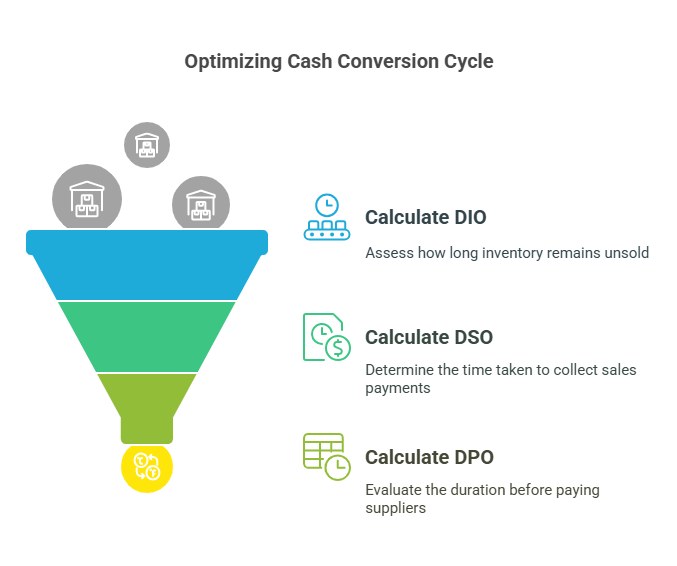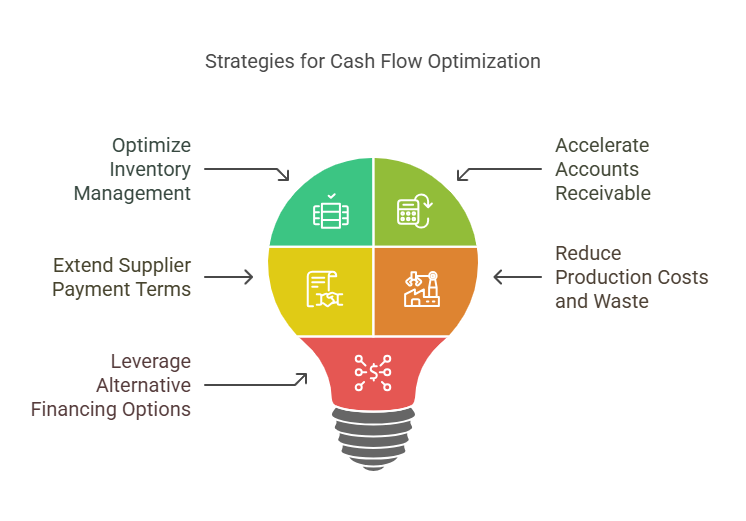In the world of manufacturing, cash flow is like the oxygen your business breathes—run short, and your operations can suffocate. Statistics show that delays in cash cycles can cripple a manufacturer’s ability to scale and survive. Yet, this doesn’t have to be your story. The cash conversion cycle (CCC) is a vital metric, measuring how long it takes for a business to convert resources like inventory and production into cash from sales. When this cycle lengthens, it ties up your capital, restricting growth and increasing financial stress. So, how do you optimize your CCC and fortify your cash flow? Here are five proven strategies.

Why CCC Matters in Manufacturing
- A long CCC can choke liquidity, making it harder to cover payroll, reinvest in equipment, or handle unexpected costs.
- Delayed payments from customers force manufacturers to rely on credit lines or loans, adding to financial stress.
- Supply chain disruptions and material price fluctuations add further uncertainty to working capital management.
If your business is experiencing any of these challenges, it’s time to take action.
5 Strategies to Improve Cash Flow and Shorten CCC

1. Optimize Inventory Management: Reduce Days Inventory Outstanding (DIO)
Implementing a just-in-time (JIT) inventory approach can be a game-changer. By aligning your production closely with demand, not only do you reduce storage costs, but you also free up cash tied up in excess inventory. Demand forecasting tools provide real-time data to adjust inventory levels intelligently. Automating your inventory tracking further enhances visibility, ensuring faster turnover of materials and reducing CCC.
2. Accelerate Accounts Receivable: Reduce Days Sales Outstanding (DSO)
Late payments from customers are a prevalent challenge. Start by offering early payment discounts to incentivize faster payments. Invoice factoring is another powerful tool—you can sell your receivables to get an immediate cash infusion. Automation tools set up payment reminders, reducing delays and administrative errors, leading to a brisker cash inflow.
3. Extend Supplier Payment Terms: Increase Days Payable Outstanding (DPO)
Negotiating better payment terms with your suppliers can give your cash flow a significant boost. By aligning supplier terms with your cash flow needs, you can retain capital longer before you need to pay it out. Leveraging supply chain financing can bridge cash flow gaps without harming supplier relationships, thus extending your DPO and reducing financial pressure.
4. Reduce Production Costs and Waste
Adopting lean manufacturing principles to minimize waste and inefficiencies in your production line will lower costs. Automation and optimizing your supply sourcing are crucial to maintaining quality while minimizing expenses. This reduction in costs translates to improved profit margins and a healthier cash flow.
5. Leverage Alternative Financing Options
Consider asset-based lending or revenue-based financing as more flexible alternatives to traditional debt. These methods allow you to leverage current assets or future revenues rather than relying solely on loans. By doing so, you can stabilize your cash flow without incurring heavy debt burdens.
By implementing these strategies, you can trim your CCC, thus unleashing the funds you need to invest back into your business. Remember, the most expensive money is the money you don’t have.
Need help optimizing your cash flow strategies? We’d be happy to discuss personalized financing options tailored to your manufacturing business. Let’s take your business to new heights.
Are you ready to turn your CCC from a bottleneck into a springboard for growth? Act now and secure the financial flexibility your operations deserve.


